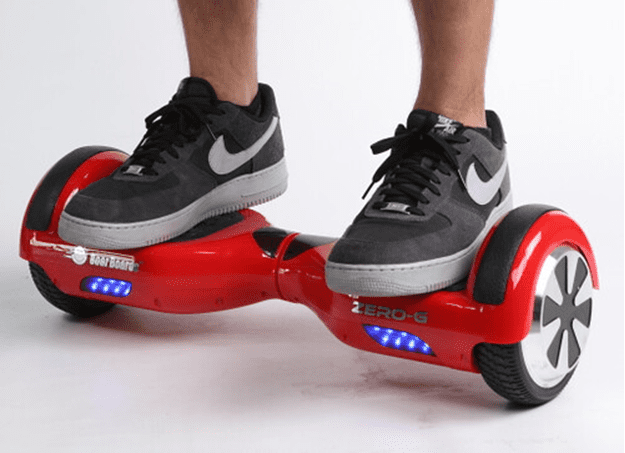The Federal Circuit has vacated two preliminary injunctions against sales of hoverboards alleged to infringe design patents.
The case is ABC Corp. I v. Partnership and Unincorporated Associations
Hangzhou Chic Intelligent Technology Co., Ltd. and Unicorn Global, Inc. (called ABC Corporation I and II in the opinion) sued several defendants that sell Gyroor hoverboards online. The plaintiffs alleged that the hoverboards at issue infringed several of the plaintiffs’ US design patents.
A district court entered a temporary restraining order followed by a preliminary injunction which enjoined the defendants/appellants from “offering for sale, selling, and importing any products not authorized by Plaintiffs and that includes any reproduction, copy or colorable imitation of the design claimed….”
The Federal Circuit determined that the preliminary injunction was procedurally improper for lack of proper Rule 65(a) notice.
FRCP 65(d) states:
(d) Contents and Scope of Every Injunction and Restraining Order.
(1) Contents. Every order granting an injunction and every restraining order must:
(A) state the reasons why it issued;
(B) state its terms specifically; and
(C) describe in reasonable detail—and not by referring to the complaint or other document—the act or acts restrained or required.
(2) Persons Bound. The order binds only the following who receive actual notice of it by personal service or otherwise:
(A) the parties;
(B) the parties’ officers, agents, servants, employees, and attorneys; and
(C) other persons who are in active concert or participation with anyone described in Rule 65(d)(2)(A) or (B).
As the court noted,
The focus of the parties’ dispute before the district court as to the 2021 injunction was whether plaintiffs had established a likelihood of success on the merits that the accused products infringed one or more claims of the asserted patents. In order to establish design patent infringement, a plaintiff must show that “an ordinary observer, familiar with the prior art designs, would be deceived into believing that the accused product is the same as the patented design.” Crocs, Inc. v. Int’l Trade Comm’n, 598 F.3d 1294, 1303 (Fed. Cir. 2010) (citing Egyptian Goddess, Inc. v. Swisa, Inc., 543 F.3d 665, 681 (Fed. Cir. 2008) (en banc)). “When the differences between the claimed and accused design are viewed in light of the prior art, the attention of the hypothetical ordinary observer will be drawn to those aspects of the claimed design that differ from the prior art.”
A central issue in the case was prior art patent No. D739,906, which claimed an hourglass shape for a hoverboard. This same shape was a prominent feature of each of the plaintiffs’ patented designs and most of the defendants’ accused products.
An expert retained by the plaintiffs testified that
Unlike the cited prior art [including the D’906 patent], the claimed design of the ‘195 Patent and the Accused Products share an integrated ‘hourglass’ body with many horizontal styling lines across the body and a relatively flat surface across the top, arched covers over the wheel area, larger radii on the front and back of the underside. Unlike any of the prior art the foot plates narrow as they extend toward the center.
The court noted that the expert didn’t explain why the hourglass body was “unlike” the prior art.
As the Federal Circuit noted,
A plaintiff seeking a preliminary injunction must establish that he is likely to succeed on the merits, that he is likely to suffer irreparable harm in the absence of preliminary relief, that the balance of equities tips in his favor, and that an injunction is in the public interest.
Design patent infringement, explained the court,
occurs when a party, “without license of the owner, (1) applies the patented design, or any colorable imitation thereof, to any article of manufacture for the purpose of sale, or (2) sells or exposes for sale any article of manufacture to which such design or colorable imitation has been applied.” 35 U.S.C. § 289. “To show infringement under the proper test, [a plaintiff must demonstrate that] an ordinary observer, familiar with the prior art designs, would be deceived into believing that the accused product is the same as the patented design.” Crocs, 598 F.3d at 1303 (citing Egyptian Goddess, 543 F.3d at 678); see also Egyptian Goddess, 543 F.3d at 676 (“When the differences between the claimed and accused design are viewed in light of the prior art, the attention of the hypothetical ordinary observer will be drawn to those aspects of the claimed design that differ from the prior art.”)
The Federal Circuit found that the district court:
- Didn’t apply the “appropriate legal standard” in issuing the injunction,
- failed to conduct the “ordinary observer” test, and
- failed to then apply the ordinary observer test “on a product-by-product basis”
Also, said the court, the language of the injunction was overbroad.
Just like the haiku above, we like to keep our posts short and sweet. Hopefully, you found this bite-sized information helpful. If you would like more information, please do not hesitate to contact us here.


